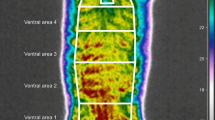Summary
The effect of clustering behaviour on metabolism, body temperature, thermal conductance and evaporative water loss was investigated in speckled mousebirds at temperatures between 5 and 36°C. Within the thermal neutral zone (approximately 30–35 °C) basal metabolic rate of clusters of two birds (32.5 J·g-1·h-1) and four birds (28.5 J·g-1·h-1) was significantly lower by about 11% and 22%, respectively, than that of individuals (36.4 J·g-1·h-1). Similarly, below the lower critical temperature, the metabolism of clusters of two and four birds was about 14% and 31% lower, respectively, than for individual birds as a result of significantly lower total thermal conductance in clustered birds. Body temperature ranged from about 36 to 41°C and was positively correlated with ambient temperature in both individuals and clusters, but was less variable in clusters. Total evaporative water loss was similar in individuals and clusters and averaged 5–6% of body weight per day below 30°C in individuals and below 25°C in clusters. Above these temperatures total evaporative water loss increased and mousebirds could dissipate between 80 and 90% of their metabolic heat production at ambient temperatures between 36 and 39°C. Mousebirds not only clustered to sleep between sunset and sunrise but were also observed to cluster during the day, even at high ambient temperature. Whereas clustering at night and during cold, wet weather serves a thermoregulatory function, in that it allows the brrds to maintain body temperature at a reduced metabolic cost, clustering during the day is probably related to maintenance of social bonds within the flock.
Similar content being viewed by others
Abbreviations
- BMR:
-
basal metabolic rate
- bw:
-
body weight
- C totab :
-
total thermal conductance
- EWI:
-
evaporative water loss
- M :
-
metabolism
- RH:
-
relative humidity
- T a :
-
ambient temperature
- T b :
-
body temperature
- T ch :
-
chamber temperature
- T cl :
-
cluster temperature
- TEWL:
-
total evaporative water loss
- LCT:
-
lower critical temperature
- TNZ:
-
thermal neutral zone
References
Aschoff J (1981) Thermal conductance in mammals and birds. Comp Biochem Physiol 69A:611–619
Aschoff J, Pohl H (1970) Der Runeumasatz von Vögeln als Funktion der Tageszeit und der Körpergröße. J Ornithol 111:38–47
Bartholomew GA, Trost CH (1970) Temperature regulation in the speckled mousebird, Colius striatus. Condor 72:141–146
Calder WA, King JR (1974) Thermal and caloric relations of birds. In: Farner DS, King JR (eds) Avian biology, vol 4. Academic Press, New York, pp 259–413
Chaplin SB (1982) The energetic significance of huddling behavior in common bushtits (Psaltriparus minimus). Auk 99:424–430
Dawson WR, Hudson JW (1970) Birds. In: Whittow GC (ed) Comparative physiology of thermoregulation, vol 1. Academic Press, New York, pp 223–310
Elkins N (1983) Weather and bird behaviour. T and AD Poyser Ltd., Calton England
Fry CH, Keith S, Urban EK (1988) The birds of Africa, vol 3. Academic Press, New York
Hoffmann R, Prinzinger R (1984) Torpor und Nahrungsausnutzung bei 4 Mausvogelarten (Coliiformes). J Ornithol 125:225–237
Levy A (1964) The accuracy of the bubble meter method for gas flow measurements. J Sci Instrum 41:449–453
Le Maho Y (1977) The emperor penguin: a strategy to live and breed in the cold. Am Sci 65:680–693
Ligon JD, Ligon SH (1978) The communal social system of the green woodhoopoe in Kenya. Living Bird 17:159–197
Ligon JD, Carey C, Ligon SH (1988) Cavity roosting and cooperative breeding in the green woodhoopoe reflect a physiological trait. Auk 105:123–127
McAtee WL (1947) Torpidity in birds. Am Midl Nat 30:191–206
McNab BK (1980) On estimating thermal conductance in endotherms. Physiol Zool 53:145–156
Pearson OP (1960) The oxygen consumption and bioenergetics of harvest mice. Physiol Zool 33:152–160
Prinzinger R (1988) Energy metabolism, body temperature and breathing parameters in non-torpid blue-naped mousebirds, Urocolius macrourus. J Comp Physiol B 157:801–806
Prinzinger R, Goppel R, Lorenz A, Kulzer E (1981) Body temperature and metabolism in the red-backed mousebird (Colius castanotus) during fasting and torpor. Comp Biochem Physiol 69A:689–692
Prinzinger R, Preßmar A, Schleucher E (1991) Body temperature in birds. Comp Biochem Physiol 99A:499–506
Reinertsen RE (1983) Nocturnal hypothermia and its energetic significance for small birds living in the Arctic and subarctic regions: a review. Polar Res 1:269–284
Rowan MK (1967) A study of the colies of southern Africa. Ostrich 38:63–115
Simmons KEL (1986) The sunning behaviour of birds. The Bristol Ornithological Club, Bristol, UK
Vogt FD, Lynch GR (1982) Influence of ambient temperature, nest availability, huddling and daily torpor on energy expenditure in the white-footed mouse (Peromyscus leucopus). Physiol Zool 55:56–63
Williams JB, du Plessis M, Siegfried WR (1991) Green wood-hoopoes (Phoeniculus purpureus) and obligate cavity roosting provide a test of the thermal insufficiency hypothesis. Auk 108:285–293
Withers PC (1977) Measurement of VO2, VCO2 and evaporative water loss with a flow-through mask. J Appl Physiol 42:120–123
Withers PC, Jarvis JUM (1980) The effect of huddling on thermoregulation and oxygen consumption of the naked molerat. Comp Biochem Physiol 66A:215–219
Yamagishi S, Kabango G (1986) The social organisation of the speckled mousebird, Colius striatus, during the dry season in tropical Africa. Ecol Res 1:329–334
Zar JH (1974) Biostatistical analysis. Prentice-Hall Inc., New Jersey, USA
Author information
Authors and Affiliations
Rights and permissions
About this article
Cite this article
Brown, C.R., Foster, G.G. The thermal and energetic significance of clustering in the speckled mousebird, Colius striatus . J Comp Physiol B 162, 658–664 (1992). https://doi.org/10.1007/BF00296648
Accepted:
Issue Date:
DOI: https://doi.org/10.1007/BF00296648




